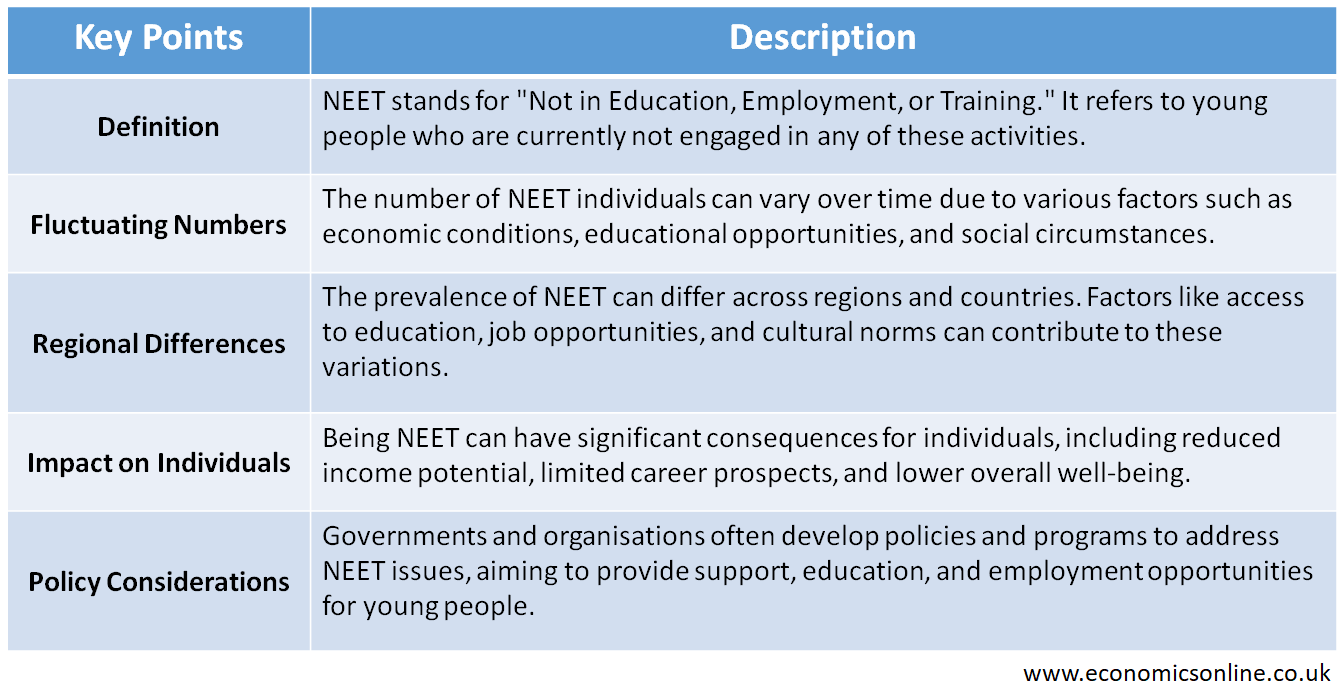
An image of a person with empty pockets.
What is a NEET?
NEET Definition
The term “Not in Employment, Education, or Training” is abbreviated as NEET. NEET is the number of young people who are neither in employment nor in education or a training programme. It is a term used to describe the youth population, which is not currently enrolled in any educational institution and is also not a part of any job or training programme.
In the UK, NEET shows the proportion of individuals aged 16–24 who are currently not engaged in work, education, or training. NEET is a relatively new indicator; however, after Britain, NEET has been embraced by other nations, including Japan, Turkey, OECD countries, and the European Union (EU), as it represents a crucial indicator of inactivity levels among the youth.
Example
For example, Mr. A has just completed his graduation but has not enrolled in a master degree programme for further studies. Mr. A is not employed or involved in any training programme yet, and he has also not found a job. Then Mr. A is considered a NEET. In this situation, NEET describes the status of Mr. A as a young person.
NEET Rate
The percentage or proportion of youth that is considered to be NEET is called the NEET rate. The NEET rate refers to those individuals who are not in education, employment, or training to indicate the level of disengagement in work or lack of opportunities in both education and work for young people classified in a specific age range within a specific area of a country.
Formula for Calculating the NEET Rate
The NEET rate can be calculated by using the following formula:

NEET Rate (%) = (Number of NEET Individuals / Total Number of Young People) x 100
The numerator of the indicator is the number of NEET individuals, which means the total number of people aged 16 to 24 who are not in education, employment, or training. This is calculated below:
NEET Rate (%) = [(Total Number of Young People - No. of Individual in Employment + No. of Individuals not in Employment but are in Education or Training)/ Total Population of Young People] x 100
A higher NEET rate indicates a higher share of youth NEETs in the young population. A higher share of NEETs can also raise concerns due to its potential repercussions, such as increased welfare payments, a higher crime rate, and a lower participation rate in the labour market.
Types of NEET
The following are some types of NEET, which are explained as follows:
Education NEET
Education NEET refers to those young individuals who are not enrolled in any form of degree or diploma in any relative subject or interest.
Employment NEET
This category includes individuals who are not currently employed or actively seeking employment.
Training NEET
These are individuals who are not engaged in any form of vocational or skills-based training programmes.
Combination NEET
This type refers to young people who are not involved in any combination of education, employment, or training activities.
Causes of NEET
The following are some major causes of NEET:
Unemployment in the Youth
The major cause of NEET is high unemployment among young people. This can be due to structural reasons where the acquired skills of youth do not match the requirements of the job market.
Lack of Skills or Training
Limited access to relevant skills or training programs (for example, apprenticeships or mentorships) can hinder young people's ability to secure employment, leading to youth NEETs.
Economic Recession
The economic recession leads to a decrease in job opportunities. This decrease makes it difficult for young people to find new jobs, and they remain unemployed persons.
Geographic Location
The availability of jobs can vary by location, and young people in remote or economically disadvantaged areas may face higher rates of NEET status.
Discrimination or Bias
Certain groups may face discrimination or bias in the labour market, which can contribute to higher rates of NEET status among the youth cohort.
Lack of Support or Guidance
Lack of support and guidance also leads to an increase in NEET individuals. Lack of guidance is due to a lack of access to career counselling or other support systems, due to which people are unable to shift from education to employment.
Lack of Women's Participation
In many countries, young women tend to be married after their education, and they become households. The women's participation rate is quite low in some Asian countries.
NEET: Key Points
The following table contains some key points of NEET:

Characteristics of NEET
The following are some characteristics of NEET, which are explained as follows:
Lack of Education
Lack of education, like formal degrees or different diplomas, affects the status of NEET individuals in society.
Unemployment
They are typically not employed and are actively seeking employment.
Disengagement
NEET individuals may feel disconnected from the workforce and educational systems.
Age Group
NEET status is most common among young people, typically between the ages of 16 and 24.
Skill Gaps
They may have limited or inadequate skills and qualifications for the available job opportunities.
Discouragement
Some NEET individuals may have experienced previous rejections or setbacks in their job search, leading to discouragement.
Social Isolation
NEET individuals may face social isolation and a lack of social networks or support systems.
Lack of Training
They often lack access to vocational or skills-based training programs that could enhance their employability.
Economic Challenges
NEET individuals may face financial difficulties due to a lack of income or unstable employment.
Potential Long-term Consequences
There is a negative long-term impact of NEET phenomenon on an individual’s life, earning potential, and overall well-being.
Impact of COVID-19 on NEET
The following points explain the impact of COVID-19 on NEET status:
Increased Unemployment
The COVID-19 pandemic has led to widespread job losses and an economic downturn, resulting in a significant increase in NEET young men and women as many businesses shut down or downsized.
Disrupted Education
School closures and the shift to remote learning have disrupted education for many students, potentially leading to increased NEET rates due to interrupted learning and limited access to educational resources.
Limited Job Opportunities
The pandemic has caused a decrease in job openings and reduced demand in various industries, making it more challenging for NEET individuals to find employment.
Skills Mismatch
The changing job market and the need for new skills in a post-pandemic world may exacerbate the skills mismatch for NEET individuals, further hindering their chances of finding suitable employment.
Mental Health Challenges
The pandemic and its associated challenges, such as social isolation, uncertainty, anxiety and depression, negatively affected the mental health of NEET individuals, making it even more difficult for them to re-engage in education or employment.
NEET in Different Countries
The following points explain NEET status in different countries:
Varying Rates
NEET rates differ across countries. Factors such as education systems, economic conditions, and social policies contribute to these variations.
Youth Unemployment
NEET rates often reflect youth unemployment. Some countries may have higher rates due to challenges in transitioning from education to employment.
Regional Differences
NEET rates can vary within regions. Factors like urban-rural disparities and access to resources can influence the prevalence of NEET individuals.
Government Initiatives
Many countries have implemented policies and programs to address NEET issues, such as vocational training, job placement services, and financial support for education.
International Comparisons
Comparing NEET rates between countries can provide insights into the effectiveness of different approaches to education, employment, and social welfare.
Focus of NEET Research
The following points explain the focus of the research on NEET individuals:
Understanding the Causes
Research aims to identify the underlying factors contributing to NEET status, such as educational disengagement, economic conditions, social barriers, and individual circumstances.
Impact on Society
Studies explore the social and economic implications of NEET individuals, including the potential long-term effects on their well-being, employment prospects, and overall societal development.
Policy Interventions
Research seeks to evaluate the effectiveness of various policy interventions and support programs aimed at reducing NEET rates and promoting successful transitions to education, employment, or training.
Regional and International Comparisons
Comparative research helps identify variations in NEET rates across different regions and countries, providing insights into the influence of cultural, economic, and educational factors.
Longitudinal Studies
Long-term research studies track the trajectories of NEET individuals over time, examining the factors that contribute to their transition out of NEET status and the outcomes they achieve.
Conclusion
In conclusion, the term NEET is an acronym or abbreviation for 'Not in Employment, Education, or Training.' NEET rate is a number which is used to determine the social exclusion, lack of economic involvement and the detachment of the youth from the labour market. NEET is aimed at evaluating the extent of young people's participation in the labour force. NEET figures can be used by the policy makers to track trends and to devise policies to make them economically active.


